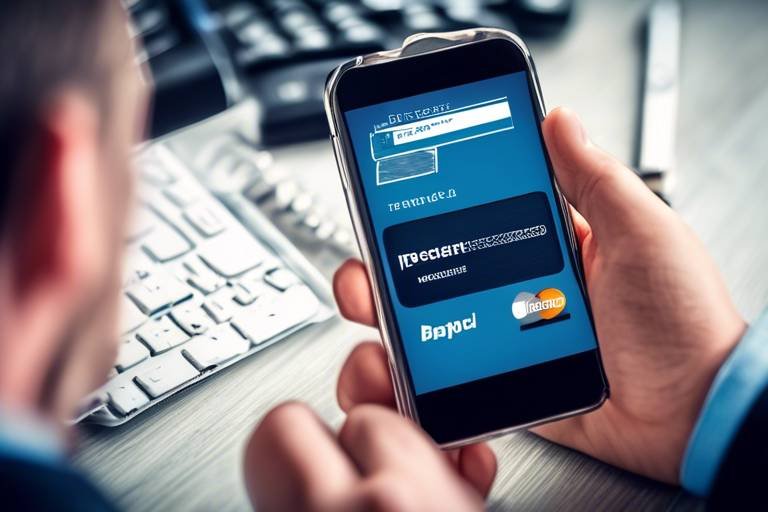The Role of Blockchain in Secure Transactions
Imagine a world where every transaction you make is not only secure but also transparent and trustworthy. This is the promise of blockchain technology, a revolutionary system that is reshaping how we think about secure transactions across various sectors. In an era where cyber threats are rampant and trust in traditional systems is waning, blockchain emerges as a beacon of hope. It offers a decentralized, tamper-proof ledger that records transactions in a way that is both efficient and secure. But what does this mean for businesses and consumers alike? In this article, we will explore how blockchain enhances the security of transactions, the benefits it brings, the challenges it faces, and its future implications for secure digital exchanges.
At its core, blockchain is a decentralized ledger system that records transactions across multiple computers. Think of it like a digital notebook that is shared among a group of friends; everyone can see what is written, and once something is recorded, it cannot be changed without everyone's consensus. This fundamental concept ensures that all participants in a transaction have access to the same information, thus enhancing transparency and security. Each transaction is grouped into a block, and these blocks are linked together in chronological order, forming a chain. This is where the name 'blockchain' comes from. The decentralized nature of blockchain means there is no single point of failure, making it incredibly resilient against attacks and fraud.
So, why should businesses and consumers care about blockchain? The advantages are numerous and compelling. Firstly, blockchain provides enhanced security. With its cryptographic techniques, it creates a robust barrier against fraud and unauthorized access, ensuring the integrity of transaction data. Secondly, it can significantly reduce costs. By eliminating intermediaries and streamlining processes, blockchain can lower transaction fees and processing times. Lastly, it increases efficiency. Transactions can be completed in real-time, allowing for faster exchanges of goods and services. These benefits not only impact businesses but also enhance the overall consumer experience.
When it comes to security, blockchain's cryptographic techniques are its crown jewels. Each transaction is encrypted and linked to the previous one, creating a secure chain that is nearly impossible to alter. This means that once a transaction is recorded, it is there for good. For businesses, this translates into a significant reduction in fraud and chargebacks. Imagine a retail store where every purchase is verified and recorded in a way that cannot be tampered with; that’s the level of security blockchain provides. Additionally, with features like digital signatures, only authorized users can access and approve transactions, further safeguarding sensitive data.
The decentralization of blockchain minimizes the risk of single points of failure. By distributing data across a network of computers, the system becomes more resilient against attacks. If one node goes down, the others continue to function, ensuring that the system remains operational. This is akin to having multiple backups of your important files; even if one copy is lost, others are still safe. This decentralization not only enhances security but also fosters a sense of trust among users, as no single entity controls the entire network.
Another compelling feature of blockchain is its transparency. Every transaction is visible to all participants in the network, which fosters trust. In industries like finance and supply chain management, where trust is paramount, this transparency can make all the difference. Imagine being able to trace the journey of a product from its origin to your doorstep, knowing every step was securely recorded; that’s the level of accountability blockchain offers. This visibility not only builds confidence among parties involved but also helps in resolving disputes quickly, as everyone can refer to the same transaction history.
Despite its numerous advantages, implementing blockchain is not without challenges. Issues such as scalability, where the network struggles to handle a growing number of transactions, and regulatory concerns pose significant hurdles. Additionally, the technology is still relatively new, and many businesses are unsure of how to integrate it into their existing systems. However, with ongoing advancements and collaborative efforts among industry leaders, potential solutions are emerging to address these concerns.
Various industries are already leveraging blockchain technology for secure transactions. From finance to supply chain management, the versatility of blockchain is becoming increasingly evident. In the financial sector, banks and financial institutions are using blockchain to streamline processes, reduce fraud, and enhance customer trust. Similarly, in supply chain management, businesses are applying blockchain to improve traceability and operational efficiency, ensuring that products are sourced ethically and delivered securely.
The financial sector is one of the primary adopters of blockchain technology. Banks are utilizing blockchain to facilitate secure transactions, reduce costs associated with payment processing, and enhance regulatory compliance. With the ability to conduct real-time transactions without the need for intermediaries, blockchain is revolutionizing how financial institutions operate. Imagine transferring money across the globe in seconds without incurring hefty fees; that’s the future blockchain promises.
Blockchain enhances transparency and traceability in supply chains. By recording every transaction on a secure ledger, businesses can track the journey of their products from origin to consumer. This not only improves operational efficiency but also builds trust with consumers who are increasingly concerned about the ethical sourcing of products. Imagine knowing exactly where your food comes from and how it was handled; blockchain makes this possible.
1. What is blockchain technology?
Blockchain is a decentralized ledger system that records transactions across multiple computers, ensuring transparency and security.
2. How does blockchain enhance transaction security?
Blockchain uses cryptographic techniques to create secure, tamper-proof records of transactions, minimizing fraud and unauthorized access.
3. What industries are using blockchain for secure transactions?
Industries such as finance, supply chain management, healthcare, and real estate are increasingly adopting blockchain technology.
4. What are the challenges of implementing blockchain?
Challenges include scalability, regulatory issues, and the need for integration with existing systems.

Understanding Blockchain Technology
Blockchain technology is often described as a revolutionary approach to data management, and for good reason. At its core, a blockchain is a decentralized ledger system that records transactions across multiple computers, ensuring that the data is not stored in a single location. This decentralization is akin to having a community library where everyone can contribute, but no one can control the entire collection. Each transaction, or block, is linked to the previous one, creating a chain of blocks that is both secure and transparent.
One of the most significant aspects of blockchain is its transparency. Every participant in the network has access to the entire ledger, allowing them to verify transactions independently. This is similar to a public scoreboard at a sports game—everyone can see the score, and there’s no room for manipulation. Because of this feature, blockchain fosters a high level of trust among users, as they can independently verify the authenticity of transactions without needing a central authority.
Moreover, blockchain employs advanced cryptographic techniques to secure data. Each transaction is encrypted and linked to the previous transaction, which makes it nearly impossible for anyone to alter the information without altering all subsequent blocks. This is like a chain of dominoes; if you try to knock down one, you’ll have to knock down the entire line to keep it from standing. This level of security is particularly crucial in our digital age, where data breaches and fraud are rampant.
In addition to security and transparency, blockchain also offers immutability. Once a transaction is recorded on the blockchain, it cannot be changed or deleted. This characteristic is vital for industries that require a permanent and verifiable record of transactions, such as finance, healthcare, and supply chain management. Imagine trying to erase a mistake in a history book; it’s not just impossible, but it would also raise questions about the integrity of the entire book.
To summarize, blockchain technology is reshaping how we think about transactions and data management. Its decentralized nature, coupled with high levels of security, transparency, and immutability, makes it an attractive option for various sectors. As we continue to explore its potential, it's essential to understand the fundamental concepts that underpin this innovative technology.
- What is blockchain technology? Blockchain is a decentralized ledger system that records transactions across multiple computers, ensuring security and transparency.
- How does blockchain ensure security? Blockchain uses cryptographic techniques to encrypt transactions, making it nearly impossible for unauthorized users to alter the data.
- What are the main benefits of using blockchain? The main benefits include enhanced security, transparency, immutability, and reduced costs in various transactions.
- Can blockchain be used in any industry? Yes, blockchain technology can be applied across multiple industries, including finance, healthcare, supply chain management, and more.

Benefits of Blockchain in Transactions
When we think about transactions in today's digital world, the term security often comes to mind. Blockchain technology has emerged as a game changer, offering a myriad of benefits that not only enhance security but also streamline processes across various sectors. Imagine a world where transactions are not only fast but also secure, transparent, and cost-effective. Sounds too good to be true? Well, let's delve into how blockchain makes this a reality.
One of the standout features of blockchain is its ability to provide enhanced security. Each transaction is encrypted and linked to the previous transaction, creating a chain of blocks that is incredibly difficult to alter. This cryptographic technique ensures that once a transaction is recorded, it cannot be tampered with, providing a level of integrity that traditional systems struggle to achieve. In a world rife with data breaches and fraud, this is a significant advantage that builds trust among users.
Moreover, blockchain reduces costs associated with transactions. By cutting out intermediaries like banks and payment processors, businesses can save on fees and streamline their operations. For instance, in traditional banking, transferring money internationally can involve several banks, each taking a cut of the transaction. With blockchain, such transfers can be executed directly between parties, significantly reducing costs and time. This is a win-win for both businesses and consumers, as it allows for more competitive pricing and faster service.
Increased efficiency is another major benefit of blockchain. Traditional transaction methods can be slow and cumbersome, often requiring multiple approvals and verifications. Blockchain simplifies this process by allowing for real-time transactions that are processed instantly. For businesses, this means quicker access to funds and improved cash flow. Consumers also benefit from faster transaction times, enhancing their overall experience.
To put it simply, the benefits of blockchain in transactions can be summarized as follows:
- Enhanced Security: Protects against fraud and unauthorized access.
- Cost Reduction: Eliminates intermediaries and lowers transaction fees.
- Increased Efficiency: Facilitates real-time transactions and improves cash flow.
As we navigate through this digital age, the implications of these benefits are profound. Businesses that adopt blockchain technology can not only improve their operational efficiencies but also gain a competitive edge in the market. Consumers, on the other hand, can enjoy a more secure and seamless transaction experience. It's a transformative shift that is already making waves across various industries.
In conclusion, the benefits of blockchain in transactions are clear and compelling. With enhanced security, reduced costs, and increased efficiency, it's no wonder that businesses and consumers alike are turning to this innovative technology. As we continue to explore the potential of blockchain, one thing is certain: the future of transactions is bright, and blockchain is leading the charge.
- What is blockchain technology?
Blockchain is a decentralized ledger system that records transactions across multiple computers, ensuring transparency and security. - How does blockchain enhance security in transactions?
Blockchain uses cryptographic techniques to create a secure chain of transactions that are difficult to alter or forge. - Can blockchain reduce transaction costs?
Yes, by eliminating intermediaries, blockchain can significantly lower transaction fees. - What industries are benefiting from blockchain?
Industries such as finance, supply chain management, and healthcare are leveraging blockchain for secure transactions.

Enhanced Security Features
When we talk about security in transactions, blockchain technology stands out like a lighthouse in a stormy sea. Its cryptographic techniques are the backbone of its security framework, providing robust measures that protect against fraud and unauthorized access. Imagine a vault that not only locks away your valuables but also alerts you if someone tries to tamper with it—that's how blockchain functions. Each transaction is encrypted and linked to the previous one, forming a chain that is incredibly difficult to break. This makes it nearly impossible for hackers to alter transaction data without being detected.
One of the core features of blockchain is its use of public and private keys. Think of these keys as a digital signature that verifies your identity and confirms your authority to conduct transactions. When you initiate a transaction, your private key creates a unique digital fingerprint that is attached to the transaction data. This way, only you can authorize the transaction, ensuring that your assets remain secure. Furthermore, the public key allows others to verify that the transaction is legitimate without revealing your private key, maintaining both security and privacy.
Another remarkable aspect is the concept of immutability. Once a transaction is recorded on the blockchain, it becomes a permanent part of the ledger. This is akin to carving your name into stone—once it's there, it can't be erased or modified without leaving behind evidence of tampering. This feature not only deters fraud but also provides a transparent history of all transactions, which is crucial for auditing and compliance purposes.
In addition, the decentralized nature of blockchain adds another layer of security. Traditional systems often rely on a central authority to manage and verify transactions, creating a single point of failure. In contrast, blockchain distributes data across a network of computers (or nodes), making it resilient against attacks. Even if one node goes down, the rest of the network continues to operate smoothly. This decentralized approach minimizes risks and enhances the overall security of the transaction process.
To summarize, the enhanced security features of blockchain technology include:
- Cryptographic Techniques: Protect against unauthorized access and fraud.
- Public and Private Keys: Ensure secure authorization of transactions.
- Immutability: Prevent alteration of transaction data once recorded.
- Decentralization: Reduce risks associated with single points of failure.
All these features work together to create a secure environment for transactions, making blockchain a game-changer in the realm of digital exchanges. As we continue to explore the vast potential of this technology, its role in safeguarding our financial and personal information becomes increasingly vital.
Q1: What is blockchain technology?
A1: Blockchain is a decentralized ledger system that records transactions across multiple computers, ensuring transparency and security.
Q2: How does blockchain enhance transaction security?
A2: Blockchain uses cryptographic techniques, public and private keys, and its immutable nature to protect against fraud and unauthorized access.
Q3: What industries benefit from blockchain technology?
A3: Various industries, including finance, supply chain management, and healthcare, leverage blockchain for secure transactions and improved efficiency.
Q4: What are the challenges in implementing blockchain?
A4: Challenges include scalability, regulatory issues, and the need for industry-wide standards, which can hinder widespread adoption.

Decentralization and Its Impact
Decentralization is one of the most revolutionary aspects of blockchain technology. Imagine a world where no single entity holds all the power – that’s what decentralization offers. By distributing data across a vast network of computers, blockchain minimizes the risk of a single point of failure. This means that if one node goes down, the rest of the network continues to operate seamlessly, much like a well-coordinated team where every member plays a crucial role.
In traditional systems, a failure in a central server can lead to catastrophic data loss or service outages. However, with blockchain, the data is replicated across numerous nodes, ensuring that it remains intact and accessible even in the event of an attack or malfunction. This resilience is akin to having multiple backups of your favorite photos stored in different places; even if one source fails, you still have access to your cherished memories.
Moreover, decentralization fosters a sense of community ownership and participation. Users are not just passive consumers; they become integral parts of the network. This creates a more democratic environment where decisions are made collectively, rather than dictated by a central authority. The transparency that comes with this setup enhances trust among participants, as everyone can see and verify transactions without relying on a middleman.
However, decentralization is not without its challenges. It can lead to slower transaction speeds, as every node must validate and record every transaction. This can be likened to a group of friends trying to agree on a restaurant – the more people involved, the longer it takes to reach a consensus. Still, the benefits of decentralization often outweigh these drawbacks, especially in terms of security and trust.
In summary, the impact of decentralization in blockchain technology is profound. It not only enhances security by eliminating single points of failure but also promotes transparency and community engagement. As we move forward, understanding and embracing this decentralized approach will be essential for harnessing the full potential of blockchain technology.
- What is decentralization in blockchain? - Decentralization refers to the distribution of data across multiple nodes in a network, reducing reliance on a central authority.
- How does decentralization improve security? - By dispersing data, it minimizes the risk of a single point of failure, making it harder for attackers to compromise the entire system.
- Are there any downsides to decentralization? - Yes, it can lead to slower transaction speeds due to the need for consensus among multiple nodes.
- How does decentralization foster trust? - Transparency in transactions allows all parties to verify and validate actions, building confidence among users.

Transparency and Trust
In today's digital age, transparency and trust are more than just buzzwords; they are essential components of any successful transaction. Blockchain technology, with its decentralized nature, offers a revolutionary way to enhance both transparency and trust among parties involved in a transaction. Imagine a world where every transaction is recorded on an immutable ledger that anyone can access. This is exactly what blockchain provides. By allowing all participants to view the same data, it eliminates the need for a middleman, thus fostering a sense of accountability.
One of the core principles of blockchain is its ability to create a permanent record of transactions. Each entry in the blockchain is time-stamped and linked to the previous one, forming a chain of events that is nearly impossible to alter. This feature not only ensures that the data remains intact but also allows for easy auditing. For example, if a consumer wants to verify the origin of a product, they can trace its journey through the supply chain directly on the blockchain, ensuring authenticity and ethical sourcing. This level of transparency builds trust, as customers feel more secure knowing exactly where their products come from and how they are handled.
Moreover, the transparent nature of blockchain can significantly reduce disputes between parties. When everyone has access to the same information, misunderstandings become far less common. Consider a scenario in the real estate sector where buyers and sellers often face issues related to property titles. With blockchain, all transactions related to a property can be recorded on a public ledger, making it easy to verify ownership and history. This not only speeds up the process but also minimizes the risk of fraud, leading to a more trustworthy environment.
To further illustrate the impact of transparency on trust, let’s look at a few key aspects:
- Real-Time Access: All parties can view transactions in real time, which helps in making informed decisions.
- Immutable Records: Once data is entered into the blockchain, it cannot be changed or deleted, ensuring that the transaction history remains intact.
- Decentralized Verification: Instead of relying on a single authority to validate transactions, multiple nodes in the network verify the data, reducing the chances of manipulation.
In conclusion, the transparency offered by blockchain not only enhances trust but also encourages ethical practices across various industries. As more businesses recognize the importance of building trust with their customers, the adoption of blockchain technology is likely to increase. By providing a clear, verifiable, and tamper-proof record of transactions, blockchain is paving the way for a more transparent future.
1. How does blockchain ensure transparency?
Blockchain records all transactions on a public ledger that is accessible to all participants, allowing them to verify and audit transactions easily.
2. Can blockchain be used in any industry?
Yes, blockchain technology can be applied in various sectors, including finance, healthcare, supply chain, and real estate, among others.
3. What are the benefits of transparency in transactions?
Transparency fosters trust, reduces disputes, and enhances accountability among parties involved in a transaction.
4. Is blockchain completely secure?
While blockchain is highly secure due to its cryptographic techniques and decentralized nature, no system is entirely immune to threats. However, it significantly reduces the risk of fraud and unauthorized access.

Challenges in Implementing Blockchain
While blockchain technology is often hailed as a revolutionary solution for secure transactions, it is not without its challenges. One of the most significant hurdles is scalability. As more transactions are processed, the blockchain can become congested, leading to slower transaction times and higher fees. Imagine a busy highway during rush hour; the more cars there are, the slower everyone moves. This analogy holds true for blockchain networks, where increased demand can lead to bottlenecks.
Another challenge is the regulatory landscape. Governments around the world are still figuring out how to regulate blockchain technology. The lack of clear guidelines can create uncertainty for businesses looking to adopt blockchain solutions. It's like trying to navigate a new city without a map; you might get to your destination, but the journey could be fraught with detours and confusion.
Moreover, there are concerns about interoperability. Different blockchain networks often operate in silos, making it difficult for them to communicate with one another. This lack of compatibility can hinder the seamless flow of information and transactions across platforms. Imagine trying to send an email from one platform to another, but the two systems don't speak the same language; this is a reality for many blockchain applications today.
Furthermore, the energy consumption associated with certain blockchain networks, particularly those using proof-of-work consensus mechanisms, raises environmental concerns. The process of mining can be incredibly energy-intensive, leading to a significant carbon footprint. As society becomes more environmentally conscious, this aspect of blockchain technology could face increasing scrutiny.
Finally, there is the issue of user education. Many potential users lack a fundamental understanding of how blockchain works, which can lead to skepticism and reluctance to adopt the technology. Education is key; without it, blockchain risks being seen as a complex and intimidating concept rather than an accessible tool for secure transactions.
In summary, while blockchain offers promising solutions for enhancing security in transactions, its implementation is not without challenges. Addressing these issues will be crucial for unlocking the full potential of blockchain technology. By focusing on scalability, regulatory clarity, interoperability, energy efficiency, and user education, stakeholders can work together to create a more robust and user-friendly blockchain ecosystem.
- What is blockchain technology?
Blockchain is a decentralized ledger system that records transactions across multiple computers, ensuring transparency and security. - How does blockchain enhance security?
Through cryptographic techniques, blockchain provides robust security measures that protect against fraud and unauthorized access. - What are the main challenges of implementing blockchain?
Major challenges include scalability, regulatory issues, interoperability, energy consumption, and user education. - Can blockchain be used in industries other than finance?
Yes, blockchain has versatile applications across various sectors, including supply chain management, healthcare, and more.

Use Cases of Blockchain in Secure Transactions
Blockchain technology is not just a buzzword; it’s a revolutionary tool that is reshaping how we handle secure transactions across various sectors. Imagine a world where every transaction is recorded on a digital ledger that is tamper-proof and transparent. This is the reality that blockchain offers, and its applications are as diverse as they are impactful. From finance to supply chain management, the use cases of blockchain are rapidly expanding, demonstrating its potential to enhance security and efficiency.
In the finance and banking sector, blockchain is a game changer. Traditional banking systems often involve multiple intermediaries, which can slow down transactions and increase costs. However, with blockchain, transactions can occur directly between parties, significantly reducing the time and fees associated with cross-border payments. For instance, banks are now using blockchain to facilitate real-time settlements, which not only speeds up the process but also reduces the risk of fraud. According to a recent report, banks utilizing blockchain technology have seen transaction costs drop by as much as 30%.
Another compelling use case is in supply chain management. In today’s global economy, tracking the flow of goods from manufacturer to consumer can be a daunting task. Blockchain enhances transparency and traceability, allowing businesses to monitor every step of the supply chain in real-time. For example, a company can use blockchain to verify the origin of raw materials, ensuring they are ethically sourced. This not only builds trust with consumers but also helps companies comply with regulations. A study found that companies implementing blockchain in their supply chains achieved a 20% increase in operational efficiency.
Furthermore, blockchain is making waves in the healthcare industry. Patient data security is paramount, and blockchain provides a solution that ensures sensitive information is securely stored and shared. By using blockchain, healthcare providers can create a decentralized database that allows patients to control their own data while enabling providers to access necessary information without compromising security. This not only protects patient privacy but also streamlines the sharing of critical health information among professionals.
In the realm of real estate, blockchain technology is streamlining property transactions. Traditionally, buying or selling property involves a mountain of paperwork and multiple parties, which can lead to delays and disputes. With blockchain, property titles can be digitized and recorded on a secure ledger, making the process of transferring ownership much more efficient. A recent survey indicated that blockchain could reduce the time it takes to close a real estate transaction by up to 50%.
As we explore these use cases, it’s clear that blockchain is not just a technological advancement but a transformative force across various industries. The ability to secure transactions while enhancing transparency and efficiency is invaluable in today’s fast-paced digital world. However, while the potential is immense, the journey to widespread adoption is still in its infancy, and ongoing innovations will shape how we interact with this technology.
- What is blockchain technology?
Blockchain is a decentralized digital ledger that records transactions across multiple computers, ensuring that the record cannot be altered retroactively without the consensus of the network.
- How does blockchain enhance transaction security?
Blockchain uses cryptographic techniques to secure data, making it nearly impossible for unauthorized users to alter transaction records, thus preventing fraud.
- What industries are using blockchain?
Industries such as finance, healthcare, supply chain management, and real estate are actively implementing blockchain technology to improve security and efficiency.
- What are the challenges of implementing blockchain?
Scalability, regulatory compliance, and the need for industry-wide standards are some of the significant challenges that hinder the widespread adoption of blockchain technology.

Finance and Banking
In the realm of finance and banking, blockchain technology has emerged as a revolutionary force, transforming the way transactions are conducted. Imagine a world where transactions occur in real-time, with unparalleled security and transparency—this is the promise of blockchain. Financial institutions are increasingly adopting this technology to streamline operations, reduce costs, and enhance security. But how exactly does blockchain achieve this?
At its core, blockchain acts as a digital ledger that records transactions across a network of computers. Each transaction is encrypted and linked to the previous one, forming a chain of blocks that is nearly impossible to alter. This cryptographic security ensures that once a transaction is recorded, it becomes a permanent part of the ledger, protecting it from fraud and unauthorized access. Imagine trying to change a page in a book that everyone has a copy of; it’s virtually impossible without everyone noticing!
One of the most significant advantages of blockchain in finance is the reduction of transaction costs. Traditional banking systems often involve multiple intermediaries, each taking a cut of the transaction. With blockchain, transactions can be executed directly between parties, eliminating the need for middlemen. This not only speeds up the process but also significantly lowers fees, making financial services more accessible to everyone.
Moreover, the efficiency of blockchain technology cannot be overstated. Transactions that once took days to process can now be completed in a matter of seconds. For example, cross-border payments, which typically involve long waits and high fees, can be executed almost instantaneously on a blockchain network. This efficiency is particularly crucial in today’s fast-paced financial environment, where businesses and consumers alike demand quick and reliable services.
However, the adoption of blockchain in finance is not without its challenges. Regulatory concerns loom large, as governments and financial institutions grapple with how to integrate this new technology into existing frameworks. Additionally, the issue of scalability arises; as more users join the network, the system must be able to handle the increased load without sacrificing speed or security.
Despite these challenges, the potential of blockchain in finance is immense. Institutions are exploring various use cases, from smart contracts to decentralized finance (DeFi) platforms. For instance, smart contracts can automate and enforce agreements without the need for a central authority, reducing the risk of disputes and enhancing trust among parties. This innovation not only streamlines processes but also opens up new avenues for financial products and services.
In conclusion, the integration of blockchain technology into the finance and banking sector is paving the way for a more secure, efficient, and transparent financial system. As institutions continue to explore its capabilities, the future of finance looks promisingly digital. The transition may be gradual, but one thing is clear: blockchain is here to stay, and it’s set to redefine how we think about money and transactions.
- What is blockchain technology? Blockchain is a decentralized ledger system that securely records transactions across multiple computers.
- How does blockchain enhance security in finance? Blockchain uses cryptographic techniques to ensure that transactions are secure, preventing fraud and unauthorized access.
- What are the benefits of using blockchain in banking? Benefits include reduced costs, increased efficiency, and enhanced security for transactions.
- What challenges does blockchain face in finance? Key challenges include regulatory issues and scalability concerns as adoption grows.

Supply Chain Management
In today's fast-paced global economy, Supply Chain Management (SCM) has become a critical component for businesses aiming to stay competitive. With the rise of e-commerce and the demand for transparency, companies are increasingly turning to blockchain technology to enhance their supply chain processes. So, what exactly does blockchain bring to the table in this context? Well, for starters, it offers a way to track products in real-time, ensuring that every step of the supply chain is documented and verifiable. Imagine being able to trace a product's journey from the manufacturer to the end consumer with just a few clicks!
One of the most significant advantages of using blockchain in supply chain management is the increased transparency it provides. Each transaction or movement of goods is recorded on a decentralized ledger that is accessible to all parties involved. This means that suppliers, manufacturers, and retailers can see the same information in real-time, reducing the risk of misinformation and disputes. For instance, if a shipment is delayed, everyone in the supply chain can quickly identify the issue and work collaboratively to resolve it, rather than playing the blame game.
Moreover, blockchain enhances traceability, which is crucial for industries like food and pharmaceuticals where safety is paramount. If a food product is recalled due to contamination, blockchain allows companies to pinpoint the exact source of the problem, enabling swift action to protect consumers. This level of accountability not only safeguards public health but also builds consumer trust in brands that prioritize safety.
However, implementing blockchain in supply chain management is not without its challenges. Companies must invest in the necessary infrastructure and technology to support this innovative system. Additionally, there are concerns about interoperability between different blockchain platforms. To tackle these challenges, many organizations are collaborating to create industry standards that facilitate smoother integration and communication between various blockchain systems.
To illustrate the impact of blockchain on supply chain management, consider the following table that highlights key benefits:
| Benefit | Description |
|---|---|
| Transparency | All parties can access the same data, reducing misinformation. |
| Traceability | Quickly identify the source of issues, enhancing safety. |
| Efficiency | Streamlined processes reduce delays and costs. |
| Accountability | Clear records of transactions foster trust among stakeholders. |
In conclusion, the integration of blockchain technology in supply chain management not only improves operational efficiency but also enhances safety and trust. As businesses continue to navigate the complexities of global supply chains, adopting blockchain could very well be the game-changer they need to thrive in an increasingly competitive landscape.
- What is blockchain technology? Blockchain is a decentralized ledger system that securely records transactions across multiple computers.
- How does blockchain improve supply chain management? It offers enhanced transparency, traceability, and efficiency, allowing for better collaboration and accountability.
- What challenges does blockchain face in supply chain applications? Key challenges include the need for infrastructure investment, interoperability issues, and regulatory concerns.
- Can blockchain be used in industries other than supply chain management? Yes, blockchain technology is versatile and can be applied in finance, healthcare, real estate, and many other sectors.
Frequently Asked Questions
- What is blockchain technology?
Blockchain technology is a decentralized ledger system that securely records transactions across a network of computers. It ensures transparency and security by allowing multiple participants to access the same data without a central authority.
- How does blockchain enhance transaction security?
Blockchain enhances transaction security through cryptographic techniques that protect data from fraud and unauthorized access. Each transaction is encrypted and linked to previous transactions, making it nearly impossible to alter any information without detection.
- What are the main benefits of using blockchain for transactions?
The primary benefits of using blockchain for transactions include enhanced security, reduced costs, and increased efficiency. These advantages help businesses and consumers by streamlining processes and building trust in the transaction system.
- What challenges does blockchain face?
Despite its advantages, blockchain technology faces challenges such as scalability, regulatory issues, and the need for interoperability with existing systems. Addressing these challenges is crucial for widespread adoption and effectiveness.
- How is blockchain used in the finance sector?
In the finance sector, blockchain is utilized by banks and financial institutions to facilitate secure and efficient transactions. It allows for real-time processing and reduces the risk of fraud, thereby enhancing overall transaction integrity.
- Can blockchain improve supply chain management?
Absolutely! Blockchain improves supply chain management by enhancing transparency and traceability. It allows businesses to track products in real-time, ensuring that every step of the supply chain is secure and verifiable.
- Is blockchain technology completely secure?
While blockchain technology offers robust security features, no system is entirely immune to risks. However, its decentralized nature and cryptographic protections significantly minimize vulnerabilities compared to traditional systems.
- What industries are adopting blockchain technology?
Various industries are adopting blockchain technology, including finance, supply chain management, healthcare, and real estate. Each sector leverages blockchain's unique capabilities to enhance security and efficiency in transactions.



















